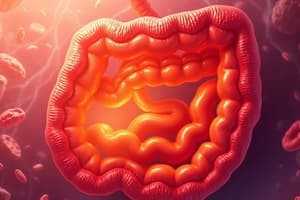Podcast
Questions and Answers
What is the process of transforming complex food into simpler food called?
What is the process of transforming complex food into simpler food called?
- Metabolism
- Assimilation
- Digestion (correct)
- Absorption
Which of the following is NOT a category of food mentioned?
Which of the following is NOT a category of food mentioned?
- Fats (correct)
- Minerals
- Salts
- Proteins
How many types of carbohydrates are classified in the content?
How many types of carbohydrates are classified in the content?
- 1
- 3 (correct)
- 2
- 4
What does the prefix 'poly' indicate in polysaccharides?
What does the prefix 'poly' indicate in polysaccharides?
Which of the following represents a monosaccharide?
Which of the following represents a monosaccharide?
What is the initial product of starch digestion in the mouth?
What is the initial product of starch digestion in the mouth?
Which enzyme is responsible for breaking down maltose into glucose?
Which enzyme is responsible for breaking down maltose into glucose?
What are monosaccharides?
What are monosaccharides?
In which part of the digestive system does the enzyme pancreatic amylase function?
In which part of the digestive system does the enzyme pancreatic amylase function?
Which of the following is a disaccharide?
Which of the following is a disaccharide?
What indicates a positive result in the iodine test for starch?
What indicates a positive result in the iodine test for starch?
What color indicates the presence of starch in the iodine test?
What color indicates the presence of starch in the iodine test?
Which is an example of a polysaccharide?
Which is an example of a polysaccharide?
What is the primary function of enzymes in the digestive system?
What is the primary function of enzymes in the digestive system?
What type of sugar is glucose classified as?
What type of sugar is glucose classified as?
Which organ is NOT part of the digestive tube?
Which organ is NOT part of the digestive tube?
What is the negative result of the iodine test for starch?
What is the negative result of the iodine test for starch?
What temperature was maintained during the sheep fat digestion experiment?
What temperature was maintained during the sheep fat digestion experiment?
Which substance is primarily responsible for emulsifying fats in digestion?
Which substance is primarily responsible for emulsifying fats in digestion?
During digestion, where do nutrients enter after being broken down?
During digestion, where do nutrients enter after being broken down?
Which test is used specifically to identify proteins?
Which test is used specifically to identify proteins?
What indicates a positive result in the Fehling's test?
What indicates a positive result in the Fehling's test?
What method is used in the lipid test to identify lipids?
What method is used in the lipid test to identify lipids?
Which of the following results indicates the presence of salt in a food sample?
Which of the following results indicates the presence of salt in a food sample?
What is the first step in the hydrolysis of starch?
What is the first step in the hydrolysis of starch?
Which enzyme is responsible for breaking down proteins into peptides?
Which enzyme is responsible for breaking down proteins into peptides?
What is produced when maltose is further broken down?
What is produced when maltose is further broken down?
At what pH are peptides broken down into amino acids?
At what pH are peptides broken down into amino acids?
How are amino acids processed after their formation?
How are amino acids processed after their formation?
Which enzyme specifically digests starch?
Which enzyme specifically digests starch?
What is the required pH for pepsin to function properly?
What is the required pH for pepsin to function properly?
How long does it take for lipids to be digested by lipase?
How long does it take for lipids to be digested by lipase?
What happens to enzymes at high temperatures?
What happens to enzymes at high temperatures?
Which enzyme needs a basic medium to function optimally?
Which enzyme needs a basic medium to function optimally?
What role do bile salts play in lipid digestion?
What role do bile salts play in lipid digestion?
Which enzyme is primarily responsible for breaking down lipids into their components?
Which enzyme is primarily responsible for breaking down lipids into their components?
What is the end product of lipid digestion?
What is the end product of lipid digestion?
In which medium does lipid digestion primarily take place?
In which medium does lipid digestion primarily take place?
Why can't lipids be directly utilized in their natural form?
Why can't lipids be directly utilized in their natural form?
What is the primary function of pepsin in protein digestion?
What is the primary function of pepsin in protein digestion?
In which environment does trypsin operate most effectively?
In which environment does trypsin operate most effectively?
What is the final product of protein digestion?
What is the final product of protein digestion?
Which enzyme is responsible for breaking down peptides in the small intestine?
Which enzyme is responsible for breaking down peptides in the small intestine?
What characteristic of the stomach environment is crucial for the activity of pepsin?
What characteristic of the stomach environment is crucial for the activity of pepsin?
Flashcards
Digestion
Digestion
The process of breaking down complex food into simpler nutrients that the body can absorb.
Carbohydrates
Carbohydrates
A class of organic compounds that includes sugars, starches, and fibers.
Monosaccharide
Monosaccharide
A single sugar unit.
Disaccharide
Disaccharide
Signup and view all the flashcards
Polysaccharide
Polysaccharide
Signup and view all the flashcards
Iodine Test
Iodine Test
Signup and view all the flashcards
Positive Iodine Test Result
Positive Iodine Test Result
Signup and view all the flashcards
What is digestion?
What is digestion?
Signup and view all the flashcards
What is the digestive tube?
What is the digestive tube?
Signup and view all the flashcards
What are digestive glands?
What are digestive glands?
Signup and view all the flashcards
What are enzymes?
What are enzymes?
Signup and view all the flashcards
What are nutrients?
What are nutrients?
Signup and view all the flashcards
What is the role of salivary amylase?
What is the role of salivary amylase?
Signup and view all the flashcards
What is maltose?
What is maltose?
Signup and view all the flashcards
Where does the breakdown of starch continue?
Where does the breakdown of starch continue?
Signup and view all the flashcards
What does maltase do?
What does maltase do?
Signup and view all the flashcards
What happens to glucose after it's broken down?
What happens to glucose after it's broken down?
Signup and view all the flashcards
What happens to starch during hydrolysis?
What happens to starch during hydrolysis?
Signup and view all the flashcards
What is the end product of starch hydrolysis?
What is the end product of starch hydrolysis?
Signup and view all the flashcards
How are proteins initially broken down in digestion?
How are proteins initially broken down in digestion?
Signup and view all the flashcards
What happens to peptides after being broken down by pepsin?
What happens to peptides after being broken down by pepsin?
Signup and view all the flashcards
What happens to amino acids after being absorbed?
What happens to amino acids after being absorbed?
Signup and view all the flashcards
Fehling's Test
Fehling's Test
Signup and view all the flashcards
Biuret Test
Biuret Test
Signup and view all the flashcards
Lipid test
Lipid test
Signup and view all the flashcards
Salt test
Salt test
Signup and view all the flashcards
What is pepsin's role in protein digestion?
What is pepsin's role in protein digestion?
Signup and view all the flashcards
What enzymes break down peptides in the small intestine?
What enzymes break down peptides in the small intestine?
Signup and view all the flashcards
What is the pH of the stomach?
What is the pH of the stomach?
Signup and view all the flashcards
What is the pH of the small intestine?
What is the pH of the small intestine?
Signup and view all the flashcards
Where do amino acids go after digestion?
Where do amino acids go after digestion?
Signup and view all the flashcards
What is emulsification in lipid digestion?
What is emulsification in lipid digestion?
Signup and view all the flashcards
What role does lipase play in lipid digestion?
What role does lipase play in lipid digestion?
Signup and view all the flashcards
What are the conditions required for lipid digestion?
What are the conditions required for lipid digestion?
Signup and view all the flashcards
What happens to the products of lipid digestion?
What happens to the products of lipid digestion?
Signup and view all the flashcards
Why is lipid digestion necessary?
Why is lipid digestion necessary?
Signup and view all the flashcards
What is a substrate?
What is a substrate?
Signup and view all the flashcards
What is the specific medium requirement for enzymes?
What is the specific medium requirement for enzymes?
Signup and view all the flashcards
Do all enzymes work at the same speed?
Do all enzymes work at the same speed?
Signup and view all the flashcards
How does temperature affect enzyme activity?
How does temperature affect enzyme activity?
Signup and view all the flashcards
What are some examples of enzymes and their functions?
What are some examples of enzymes and their functions?
Signup and view all the flashcards



